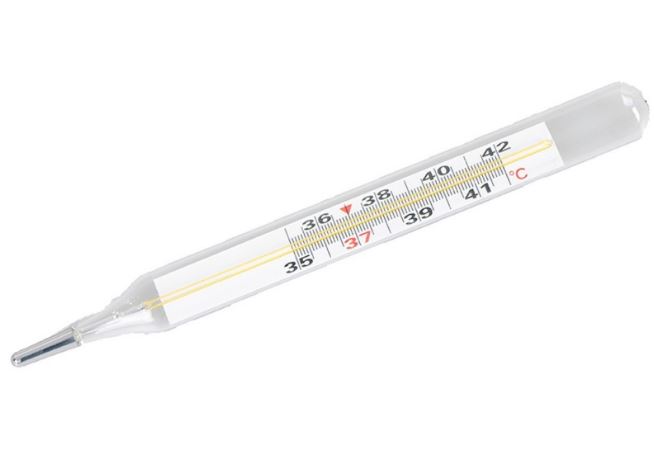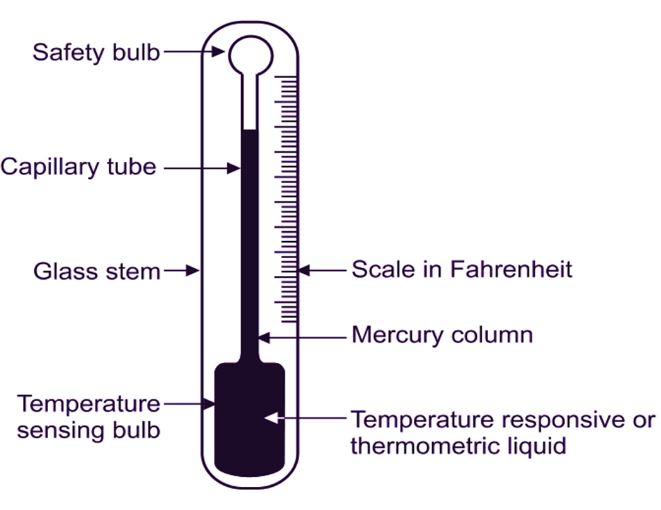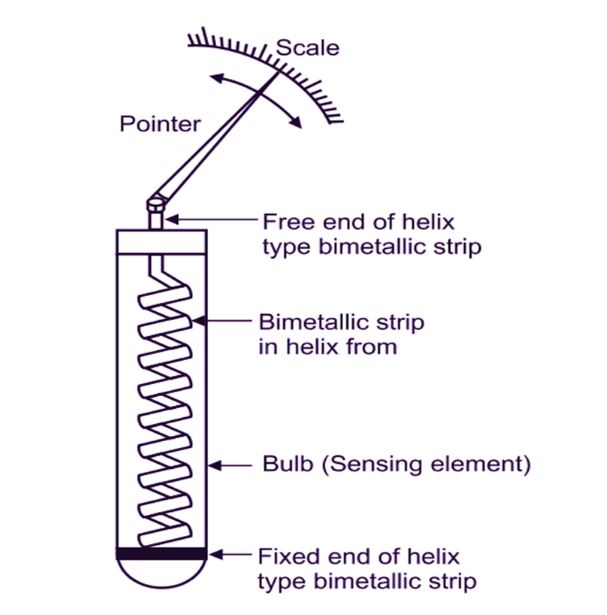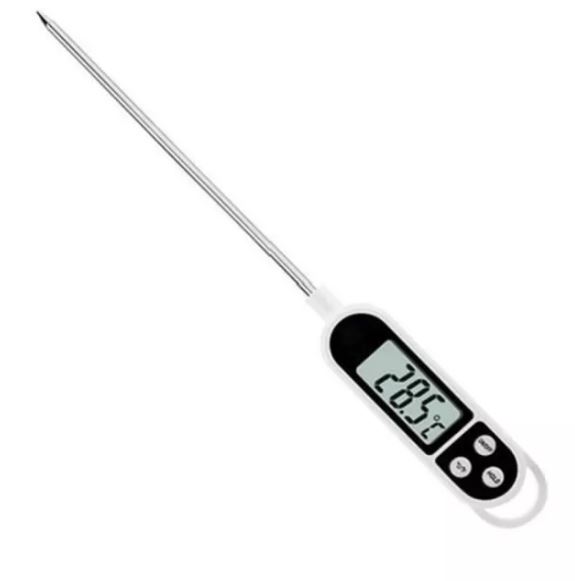Table of Contents
Thermometer and Temperature
The thermometer is the common tool used to measure temperature. Heat and temperature are two terms that frequently cause misunderstandings. How would you, for instance, express how hot something is? What serves as a measurement or foundation for that heat? Temperature is the answer to it. The unit of heat energy is called a joule. However, the way that heat is measured is by its temperature. Accordingly, if the heat is greater, the temperature is greater than normal. However, how can we gauge the temperature? To measure an object’s temperature, we utilise a tool called a thermometer. The measurement of how hot or cold something is is what is referred to as its temperature. It is a mathematical illustration of heat. Temperatures are measured using a variety of units, including Celsius (C), Kelvin (K), and Fahrenheit (F).
The needs of each type of thermometer determines how they are categorised. For instance, one set of thermometers is used to measure body temperature, while another set is used to measure boiling point and freezing point during experiments.
History of Thermometer
Thermometer, a device for determining a system’s temperature. A vast range of activities, including manufacturing, scientific research, and medical practise, depend on accurate temperature measurement.

The Italian mathematician and physicist Galileo Galilei is largely credited with creating the this device. His device, which was created in 1592, used the expansion and contraction of the air inside an inverted glass vessel to adjust the level of the liquid that was partially filled up the vessel’s long, open-mouthed neck. This broad idea was refined throughout the years by working with liquids like mercury and creating a scale to quantify the expansion and contraction caused by changing temperatures in these liquids.
As many as 35 different temperature scales have been developed by the early 18th century. Daniel Gabriel Fahrenheit, a German physicist, created precise mercury thermometers calibrated to a standard scale between 32° and 96°, which corresponded to the body’s temperature. The difference between the boiling (212°) and freezing points of water is divided by 180 to get the Fahrenheit temperature scale’s unit of measurement, or degree. The Swedish astronomer Anders Celsius is credited with creating the first centigrade scale, which consists of 100 degrees, in 1742. The melting point of snow is 100 degrees, and Celsius uses 0 degrees for the boiling point of water. Later, this was reversed to have 0 degrees on the cold end and 100 degrees on the hot end, and in that form, it became quite popular. The Celsius temperature scale replaced the earlier name of the simple centigrade scale in 1948. The degree Celsius unit of this scale is currently known as the kelvin. In 1848, the British physicist William Thomson (later Lord Kelvin) suggested a system that employed the degree Celsius but was keyed to absolute zero (-273.15 °C). The Fahrenheit degree is linked to absolute zero (-459.67 °F) on the Rankine scale.
Different Types of Thermometer | Types of Thermometer:
Various sizes and shapes of thermometers are available depending on the requirements of the user. As already mentioned, their primary function is to gauge an object’s temperature (living and non-living). As a result, one kind of thermometer is used to measure body temperature. However, a different set of thermometers is used to measure temperatures in studies or laboratory tests. The several thermometers that we employ on a daily basis are as follows:
Medical/clinical thermometer:
Clinical thermometers are only to be used in clinical purposes. It was created to measure the body temperature of people. It has a mercury-filled bulb at the end of a long, narrow glass tube. The average body temperature of an adult is 37 °C, though this can vary from 35 °C to 42 °C. Thus, the range of the clinical thermometers is 35 to 42 degrees Celsius. Our body temperature is indicated in Celsius by the mercury level. These thermometers have been replaced by digital thermometers in modern times because mercury is a poisonous substance.





How should a thermometer be read? | How to read Thermometer reading?
Clean the thermometer by using water that is at normal temperature..
Give several jerks to it. The mercury level is seen to decrease as a result of the jerks. The usual body temperature of an adult is 37 degrees Celsius, or 98 degrees Fahrenheit, so we make sure it doesn’t get too hot.
After that, to obtain the thermometer’s reading, hold it either under the tongue or under the arms.
After few seconds take it out from the armpit or tongue.
Then bring up the thermometer close to the eye in order to obtain the accurate reading.
Digital thermometer
These thermometers are employed to measure temperature using an electrical circuit. The information is taken in and transferred to a microchip, which processes it and displays the results numerically on the digital display. They are accurate, affordable, and simple to use. When it comes to measuring body temperature, digital thermometers can be regarded as advanced thermometers.





How do I use a digital thermometer?| How to use digital thermometer?
The thermometer should be turned on, and you should see display reading “room temperature in Fahrenheit degree .”
Put the thermometer’s tip under your armpit or under your tongue.
Wait a few seconds until You won’t hear the thermometer’s alarm.
Check the display temperature after removing the thermometer from armpit.
After usage, wipe the thermometer’s tip with cloth and alcohol
Infrared Thermometer | Ear thermometer with infrared technology:
Electronic ear thermometers measure body temperature from inside the ear canal using infrared technology. this is also called Tympanic thermometers. Tympanic thermometers use the tympanic membrane in the ear to monitor temperature, hence their name. Children benefit greatly from this kind of thermometers. They are, however, pricey, and they might not detect the body temperature precisely if the thermometer is not inserted correctly or if there is too much wax within the ear.Infrared energy released by the heat source is used by electronic ear thermometers to calculate body temperature. These thermometers can thus immediately record body temperatures.





Forehead Thermometer:
The electronic ear and forehead thermometers both measure heat using infrared technology. The superficial temporal artery, a branch of the carotid artery, is monitored using infrared sensors. These contemporary thermometers are widely used to measure people’s body temperatures in stadiums, malls, and transit hubs. The primary cause of their fame is their tendency of avoiding contact. This implies that no physical contact is necessary when taking temperature readings with a forehead thermometer.





The temperature readings on forehead thermometers are normally 1°F (0.6°C) lower than those of digital thermometers because they are less accurate than regular digital thermometers.
Pacifiers Thermometer :
The target audience for pacifier thermometers is newborns who are at least three months old. The simplest method to determine a baby’s body temperature may be to use a pacifier if it makes him or her feel comfortable. Pacifier thermometers are easy to use, but they only record approximations of body temperatures and are imprecise. They require the baby to be still for a few minutes so they can check the body temperature, which could be challenging. Temperature readings may become inaccurate as a result of this.





The pacifier has a connector and at least one temperature sensor; it also has a flexible cover with a round opening and a hollow seat for the connector; when the pacifier is not connected to the measuring unit, the round opening with the flexible cover is closed to shield the connector and temperature sensor from dust and moisture; and the temperature sensor by a pacifier connected to the measuring unit. and wherein the temperature sensor is secured in the pacifier by a pacifier connected to a trough that is covered and glued to the pacifier; the measuring device includes an on/off switch, a display, and an electronic circuit board with a temperature measuring circuit that includes at least the temperature sensor.
Forehead Strip Thermometer:
Plastic strip thermometers are inefficient for measuring body temperatures since they don’t give accurate temperature readings. They act as a reference to figuring out if someone has a fever or not. Plastic strip thermometers require us to lay the strip on our forehead, where it will change colours in accordance with our body temperature. There’s a good chance you have a fever if the colour change to dangers. These thermometers are not trustworthy. They can be thrown away single-phase thermometers as well.





Plastic strip thermometer known also as a liquid crystal thermometer or temperature strip. Plastic strip thermometer uses heat-sensitive (thermochromic) liquid crystals embedded in a plastic strip that change colour to represent various temperatures.
Laboratory thermometer:
Clinical thermometers cannot be used to measure temperature outside of the human body, hence we require a unique kind of thermometer for these other uses. The term “lab thermometer” refers to a device that is used in laboratories to measure temperatures other than body temperatures. From -10 C to 110 C, that is a wide range. When evaluating the boiling point, freezing point, or temperature of other substances, laboratory thermometers are used. A laboratory thermometer can be used to determine the temperature of a solvent, but not a clinical one.





Liquid in Glass Thermometer | working Principle of Liquid in Glass Thermometer:
As the name suggests, liquid-in-glass thermometers are constructed with a sealed glass container that contains a liquid, such as red alcohol or mercury. As the temperature changes, the volume of liquids in thermometers also changes. The liquid expands in reaction to the temperature increase. The temperature can also be determined by the liquid’s level of rinse in the glass tube. Due to the glass tube, these thermometers are brittle. They are therefore kept in safe housings with temperature readings recorded on them. Liquid-in-glass thermometers are also practical, affordable, and perfectly suited for locations where there is an electrical issue because they do not require a power source.





Mercury thermometer:
Mercury thermometers are the most fundamental thermometers and were previously the only means of measuring body temperature. They are the most accurate thermometers and function similarly to digital thermometers. On the other hand, these thermometers does not required any electrical circuits or displays and do not rely on batteries. Glass tubes with different temperature readings make up the body of mercury thermometers. Mercury in liquid form is present at one end of the glass. It is utilised in thermometers as a result of its high coefficient of expansion, which makes it simple to move within the thermometers in accordance with temperature.
The idea behind mercury thermometers is that liquids expand when they are heated and contract when they are cooled. As a result, the mercury expands and rises up the tube as the temperature rises, then contracts and does the opposite as the temperature falls.
Mercury in this thermometer starts to rise as soon as we place it under our tongue or armpit and reflects our body temperature. Body temperature should be read when the mercury has completed its travel. As a result of their fragility, these thermometers are not usable in various industries. Mercury is a deadly liquid. On the other hand, mercury thermometers are no longer widely used due to safety concerns (mercury poisoning) and are prohibited in many nations.
Alcohol thermometer:
This thermometer resembles a mercury thermometer except that alcohol is used as the filler instead of mercury. Alcohols are more sensitive to temperature fluctuations, making it possible to read the test data and determine the amount accurately. Furthermore, compared to mercury thermometers, this thermometer is more secure. Due to its ability to measure low temperatures, this thermometer is often referred to as a minimum thermometer.
Constant-pressure gas thermometer:
The constant pressure gas thermometer is based on the idea that changes in volume correspond to changes in temperature while the process’s pressure stays constant.This consists of a long, thin glass tube that is sealed by a rubber stopper and contains a known constant mass of air and mercury.The Isobaric process is the name given to such processes.





Then, a bigger, open tube that allows liquid or gas to freely travel through is placed around the tube, air, and mercury.The air either expands or contracts as the inner tube’s temperature changes, transporting the mercury along the tube.
We can determine how much the mercury has expanded at various temperatures by measuring the amount of movement in it.
Constant volume thermometer:
A mercury manometer is typically attached to a bulb that is filled with a fixed volume of a diluted gas in order to create a constant volume gas thermometer.The manometer is used to measure pressure variation of gas. Constant volume gas thermometers works on the principle of Law of Gay-Lussac.
According to the law, an ideal gas’s pressure rises in direct proportion to its temperature.
Additionally, as temperature drops, so does pressure in a similar manner.
Constant volume gas thermometers measure the rise in temperature as a function of changing pressure while maintaining a constant volume.
These thermometers are used to calibrate a number of other thermometers.





Mechanical bimetal thermometer | Bimetallic Strip Thermometer:
A mechanical bimetal thermometer is a thermometer that makes use of two metals with various coefficients of expansion to produce certain effects. Bi and metal are two and metal, respectively, as suggested by their names.





The two metals will expand and start to distort whenever there is a temperature change. In response to the curvature of the two metals at that point, the thermometer’s needle moves and displays the temperature.
The bimetal strip will bend in the direction of the metal with a high expansion coefficient, or vice versa, depending on whether it is hot or cold outside. The temperature of thermostats, ovens, grills, and other industrial instruments are measured using this bimetal thermometer as a gauge for a heat threshold.
Maximum-Minimum Thermometer (Six Bellani Thermometer):
A maximum-minimum thermometer is a thermometer that is used to record the highest and lowest temperatures experienced in a location over a specific time period. This thermometer is also known as the Six Bellani thermometer because it was created by James Six Bellani.





The working principle is that as the temperature rises, the mercury in the ball will expand and force the narrow portion into the scalded capillary tube.
The highest air temperature can be seen on the mercury tip to the right. The mercury column will then stay in place as a result of the little pipe holding it back when the air temperature drops. You need to swing it firmly in order to get it to go back to its starting position.
Resistance thermometer | Platinum resistance thermometer:
A thermometer called a resistance thermometer is used to measure extremely high temperatures, such as those between -250°C and 700°C. This thermometer measures changes in the resistance of platinum wire that is encircled by a piece of glass or ceramic.





Due to its high precision and wide temperature range, platinum is employed. If there isn’t any platinum available, copper or nickel can be used in its place. Common applications for this thermometer include automation and process control. Click here to know more about RTD
Thermocouple thermometer:
A thermocouple is a temperature-measuring instrument. It consists of two disparate metallic wires that have been linked to create a junction. A modest voltage that can be detected in the thermocouple’s electrical circuit when the junction is heated or cooled corresponds to temperature. Click here to Know more thermocouple





Pyrometer thermometer:
An infrared thermometer employs infrared or laser light to measure the temperature of a specific object or body part without touching the object.





It operates by sensing the thermal radiation that infrared-emitting objects release. Recently, thermometers of this kind have become widely used. In order to comply with health regulations during the COVID-19 epidemic, it is utilised to test a person’s body temperature prior to their entry into the throng. Click here to Know more about Pyrometer working Principle
Probe Thermometer:
The probe thermometer is a thermometer with a lengthy cable connecting it to the sensor tip, which is tapered. What is used to measure heat is the pointy tip. By touching the it’s tip to the object, it is typically utilised in the health, laboratory, retail, and food industries. The cable’s length enables a range of possible uses.





Humidity Thermometer:
A device that measures the humidity in the room is called a humidity thermometer. This thermometer has an electrical sensor that can measure the ambient temperature at a certain moment. Thus, variations in the relative humidity of the room affect the temperature reading on this thermometer.





Due to the fact that it occasionally comes with a clock, this can be found in a laboratory or as a household addition.
These are the several thermometer types. Each thermometer has advantages and cons of its own. Make sure you don’t select the incorrect thermometer while attempting to measure the temperature of an object once you are aware of the varieties of thermometers mentioned above.
How can a thermometer’s accuracy be determined?
The stem of the thermometer must be inserted into the ice water at least an inch deep without contacting the glass in order to determine whether it is accurate. Wait for a minute or less to ensure that the thermometer reads the ice water’s temperature. The thermometer is regarded to be accurate if the reading is 32°F or 0°C.
Who invented the thermometer? | Who is the father of thermometer?
The father of the thermometer is regarded as Daniel Gabriel Fahrenheit. His life was devoted to science and inventions as a German physicist. Fahrenheit is credited for developing the current mercury thermometer. In addition, he is credited with developing the mercury-in-glass thermometer.
Why the thermometer is kept under the tongue ?
Under the tongue, there is the body’s internal heat. To obtain an accurate reading of internal body temperature, a thermometer is placed under the tongue. We are able to measure our body’s overall temperature in this manner.
Recommended articles.